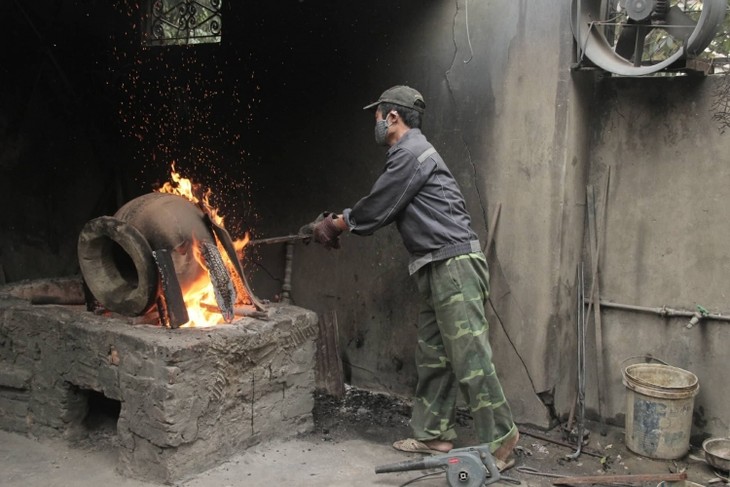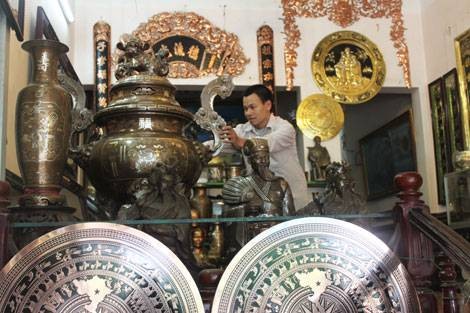(VOVWORLD) - Located about 20km from Nam Dinh city, Tong Xa bronze casting village in Yen Xa commune, Nam Dinh province, is a center of the traditional bronze casting craft. For nearly 900 years, bronze casting has been preserved and developed by the village.
|
 A caster is melting bronze before pouring it into the molds. A caster is melting bronze before pouring it into the molds.
(Photo: phapluat.tuoitrethudo.com.vn)
|
About 900 years ago, in Yen Khanh district (now in Ninh Binh province), Nguyen Chi Thanh followed Zen Master Giac Khong to become a monk at a young age.
He travelled to many regions to teach others. In Tong Xa, he taught the villagers how to make molds for casting bronze. Centuries later, the craft is still practiced here.
To remember his merits, the villagers built a temple to worship him. Every year, in the middle of the 2nd lunar month, the village holds a festival to commemorate the merits of the Founder.
Today, Tong Xa’s bronze casting furnaces burn from dawn till dusk.
Every stage of bronze casting-choosing the right clay for the kiln, controlling the fire, making the molds, and melting the bronze, must be done carefully and correctly to ensure the quality of the finished products.
In the old days, Tong Xa villagers only produced simple household and worship items. Today, its products are extremely diverse in design and function. Many are displayed at historical and cultural heritage sites.
Do Thanh Vy, a local artisan, said there are 5 main steps in making a bronze item. The most important step is making the clay molds.
“When taking an item out of the mold, you need to remove it evenly. If any part of the product is too thin, it will be easy to puncture,” said Vy.
Bronze statues are a signature product of Tong Xa. They have made the village famous both in Vietnam and abroad.
Casting statues requires skillful technique and often involves carefully guarded craft secrets, said artisan Vu Duy Thuan.
He said: “A caster can be called a craftsman when he has a passion for the craft and can imbue his statues with a soul. An artisan must be meticulous, hard-working, and always alert to new ideas.
Another Tong Xa artisan named Duong Van Lan said bronze casting is hard work. Casters must be strong and have endurance and resistance. It is a challenge to stand by the hot kiln to heat the bronze and pour it into the mold.
Lan shares his experience: “In the summer when the temperature of the kiln is over 1 thousand degrees Celsius, the area within 20 meters will be between 60 and 70 degrees Celsius. Despite the heat, we do our best to create sophisticated products.”
 Tong Xa finished products (Photo: dongyyen.com.vn) Tong Xa finished products (Photo: dongyyen.com.vn) |
After the bronze is poured into the mold, workers must wait until it has hardened and cooled before removing it from the mold.
He said these are raw products which need to undergo another important step: “When making worship items, workers must pay special attention to filing and engraving. Items with beautiful designs and reliefs are more attractive to customers.”
Artisan Nguyen Cong Hon said that most of the bronze casting steps are done manually in the traditional way. This ensures that each product is smooth, beautiful, and delicate.
“When I create a beautiful item, I want to make it even more beautiful. A caster must take as much time as necessary and be diligent, even anxious, about the end product. You need a passion for the craft,” said Hon.
Bronze items made by Tong Xa village have been exported to more than 70 countries.